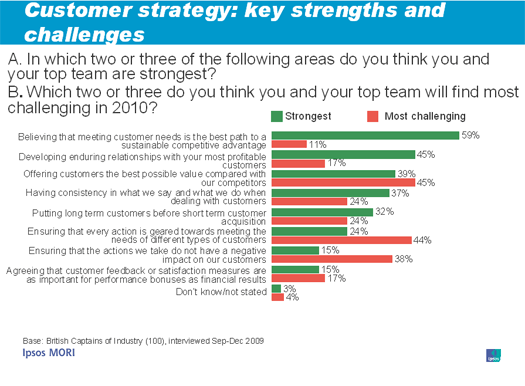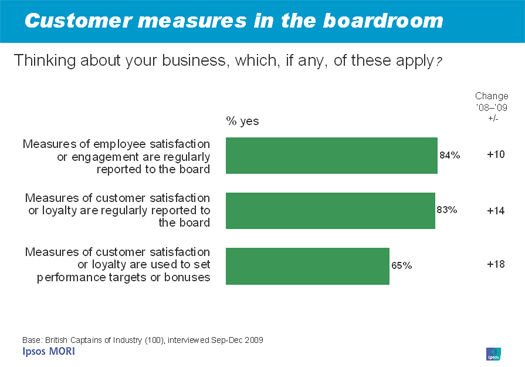Customer Strategy in the Boardroom
First of all, some good news. The view from the boardroom suggests that things are getting better. Our latest Captains of Industry research among business leaders shows that they feel more optimistic about the economy than at any point in the past six years.
It has been a gloomy old time and the recession has shaken up the business world in many respects. A majority of business leaders (71%) say it has forced them to take tough decisions they have sometimes put off making in the past.
And many businesses have had to rethink their customer offer. Just under half (45%) of Captains say the recession has forced them to change their product or service offering. This is echoed by our latest research among members of the Chartered Institute of Marketing: 72% agree that there has been a fundamental shift in their customers' behaviours and spending patterns since the start of the recession.
However our research shows that one strategic imperative remains unchanged. Customer retention (chosen by 49%) is still a greater priority than customer acquisition (chosen by 24%) for most business leaders.
When we asked about customer strategy in more detail, the areas where business leaders thought they and their teams are strongest are:
- Believing that meeting customer needs is the best path to a sustainable competitive advantage (59%); and
- Developing enduring relationships with their most profitable customers (45%)

So the strategic imperative of meeting customer needs is clearly agreed, as is the emphasis on the most profitable customers. But the devil, as ever, is in the execution. When asked to identify their biggest challenges in 2010 as far as customer strategy is concerned, business leaders' top answers are:
- Offering customers the best possible value compared to competitors (45%); and
- Ensuring that every action is geared towards meeting the needs of different customers (44%)
Business leaders feel reasonably confident about matching competitors for value: 39% see this as one of their strengths. But only 24% say ensuring everything in the business is focused on meeting the needs of different customers is a strong point.
Part of the challenge here is effectively managing the torrent of customer data which flows through a business. Our research among members of the Chartered Institute of Marketing found that only 9% of those using CRM feel that their systems are very effective at allowing accurate analysis and profiling of customers and customers segments, while only 26% say that their marketing function has a high level of visibility over all of their organisation's relevant customer data.
While customer data has never been just a marketing or operational issue, one trend our research picks up is that customer measures are finding their way into more and more boardrooms. Over four-fifths (83%) of business leaders say that that measures of customer satisfaction/loyalty are regularly reported to the board, up 14 percentage points from the year before. Around two thirds (65%) say that these measures are used to set performance targets or bonuses, up 18 percentage points. Customer management is clearly developing a harder edge.

Finally, we asked business leaders who they think leads the way as far as excellent customer service is concerned. As was the case last year, Tesco comes top, mentioned by 25%. The rest of the list is dominated by retailers. This is in line with what we have found in our general public research: supermarkets beat other sectors hands down when it comes to perceptions of offering fair deals and treating customers well.
So what conclusions can we draw from all of this? Clearly the recession has forced many businesses to reappraise the way they do things. And, as times have got tougher, hard measures of customer satisfaction and loyalty have become more influential. This trend is unlikely to reverse. The rise of social media means that the voice of the customer has become harder than ever to ignore. The challenge for the boardroom - and the rest of the business - is how to piece together the different bits of the customer jigsaw to build stronger customer relationships.
View the article at Loyalty Magazine here



